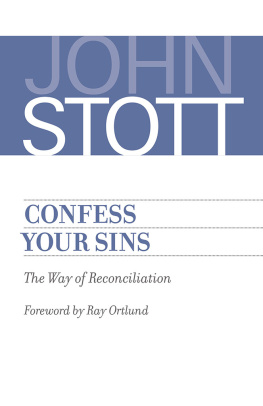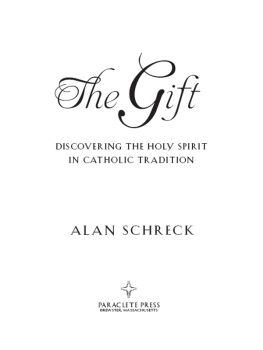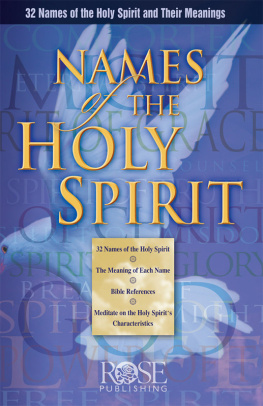Baptism
and Fullness
The Work of the Holy Spirit Today
JOHN STOTT
FOREWORD BY MICHAEL HORTON
InterVarsity Press
P.O. Box 1400, Downers Grove, IL 60515-1426
World Wide Web: www.ivpress.com
E-mail:
First edition 1964 titled The Baptism and Fullness of the Holy Spirit
Second edition 1975 by Inter-Varsity Press, Leicester, England
Third edition 2006 by Inter-Varsity Press, Leicester, England
Published in the United States of America by InterVarsity Press, Downers Grove, Illinois, with permission from Universities and Colleges Christian Fellowship, England.
All rights reserved. No part of this book may be reproduced in any form without written permission from InterVarsity Press.
InterVarsity Pressis the book-publishing division of InterVarsity Christian Fellowship/USA, a movement of students and faculty active on campus at hundreds of universities, colleges and schools of nursing in the United States of America, and a member movement of the International Fellowship of Evangelical Students. For information about local and regional activities, write Public Relations Dept., InterVarsity Christian Fellowship/USA, 6400 Schroeder Rd., P.O. Box 7895, Madison, WI 53707-7895, or visit the IVCF website at .
The Scripture quotations quoted herein are from the Revised Standard Version of the Bible, copyright 1946, 1952, 1971 by the Division of Christian Education of the National Council of the Churches of Christ in the U.S.A. Used by permission. All rights reserved.
Design: Cindy Kiple
Images: Anna Minkevich/iStockphoto
ISBN 978-0-8308-8424-7 (digital)
ISBN 978-0-8308-3402-0 (print)
This digital document has been produced by Nord Compo.
Foreword
F ew conference talks have flowered so richly into an evangelical classic as the little book you are about to read. Published in 1964, Baptism and Fullness appeared just prior to the explosive growth of the charismatic movement in mainline churches. With the second edition in 1975, slightly revised yet unchanged in its basic orientation, the book found its way onto the essential reading lists for those on both sides of the debates concerning the work of the Spirit.
What accounts for its enduring popularity? After all, Baptism and Fullness is, as you can plainly see, a rather small book. I would like to offer a few suggestions as to why it has been such a profound resource, since a mere commendation for someone like Stott from someone like me seems a little pretentious.
First, everything that John Stott writes exhales the Scriptures that one can easily discern have been deeply inhaled as the atmosphere of the authors daily walk with Christ as well as academic study. While doing my doctoral studies at Wycliffe Hall, Oxford, I came into daily contact with a new generation of Anglican evangelicals who were Stotts spiritual children. And, as they say over there, the proof of the pudding is in the eating. I found myself challenged by their zeal for personal Bible study and prayer, which yielded a passionate and informed evangelistic witness. Our conversations turned on passages of Scripture, not simply on relevant topics, and when the latter came up, appeals quickly went to the biblical text. However, John Stotts brand of exegesis (biblical interpretation) is not a wooden biblicism, where one simply inserts quotations for a party view. Rather, he explains the Scriptures, but what he explains are the Scriptures. All who love to breathe that atmosphere of genuine Bible studythe sort of thing that seems less pervasive in personal and corporate church life among us today than it was perhaps a generation agond a book like Baptism and Fullness a rewarding experience regardless of their position on the issues it addresses.
Second, Christ is the center of this, as all of Stotts other writings and sermons. Since Christ is the center of Scripture itself, that is as it should be. This book reminds us that wherever we land on the issues related to spiritual gifts, the primary role of the Holy Spirit is to witness to Christ and to equip the church as the witness to Christ, that in everything he might have preeminence (Col 1:18). One can therefore discern where the Spirit is genuinely present in power as the vital wellspring of Christs body when Christ is being proclaimed with clarity, truth and conviction, and people are being conformed to Christs likeness. After all, the evidence of the descent of the Spirit at Pentecost was, just as Jesus had promised before his ascension, the preaching of Peter and the other apostles that led to repentance and faith, with baptism and the Lords Supper uniting believers in a fellowship of worship and witness.
Third, John Stott is not wary of talking about the Holy Spirit. If Christ is the center, the Spirit is recognized in this book as the person of the Trinity who keeps our eyes on Christ while empowering us for personal and corporate life. Especially in the context of controversy, many writers have approached the gifts with a polemical attitude, eager to advance a particular side of the debate. There is no doubt a place for such writing, but this book, characteristic of Stotts ministry, is the work of a missionary pastor who has always maintained a rather cheerful condence that a careful consideration of the Scriptures will yield greater unity among Gods people. The rst line in his introduction sets the tone: Wherever one looks in the church today, there is an evident need for a deeper work of the Holy Spirit. By this Stott does not mean that the church needs some new work that is distinct from Pentecost. At the same time, he does not regard Pentecost merely as a past event with little connection to us today. Rather, he argues, the church easily forgets the person and work of the Holy Spirit, or at least takes the Spirit for granted. Gods Word must determine the legitimacy of Christian experience, but the latter, for Stott, is not to be neglected.
After laying down the ground rules for interpreting the relevant biblical passages, the author walks us through the dramatic events concerning the general outpouring of the Spirit that were prophesied and fullled in the history of redemption. From there he takes up the more controversial matters that are still very much alive in the questions and discussions of Christians today. On one hand, Stott is concerned that some of the claims in the controversies over the Spirits work have divided Christs body into the haves and the have nots. The Spirit, he maintains, is given to every believer. On the other hand, the Scriptures call believers to a greater fullness of the Spirit as they grow up into the unity of Christs body. Hence the distinction evident in the title: baptism in the Spirit belongs to the whole body, while fullness ebbs and flows.
Although he is irenic, fair and balanced in his approach, this book does not evidence a forced attempt at a middle way between charismatics and noncharismatics. Like a good pastor, Stotts conclusions are sometimes jarring and cautionary. Furthermore, regardless of where the reader stands in that debate, there is plenty of wise criticism to go around. There are points at which both parties may take exception to the arguments presented or wish that more had been said. Yet even at those moments, one cannot fail to be impressed with the constant attentiveness to Gods Word.




















